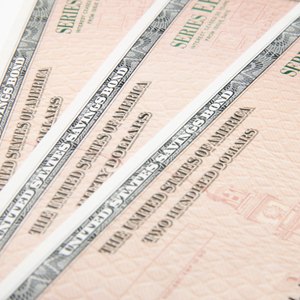
Bonds are loans freely traded over the exchange. Generally, they are redeemable and pay a fixed interest percentage on the par value of the bond. ("Par value" is the bond's face value, or the amount you receive when you turn in the bond.) The calculation of a bond’s maturity is conducted by determining the yield amounts of a bond or a portfolio of bonds at an effective interest rate at the time of principal repayment. ("Yield" is the return you get for your bond.) The effective maturity of a bond refers to the effective yield or effective rate of interest of the bond at the culmination of its tenure. ("Tenure" is the length of time until the bond matures.)
Calculate the amount of interest paid yearly by the bond. Yield to maturity takes into account the annual coupon payments, as well as the principal that has to be paid at the maturity date. For example, 10 percent on a $100 bond is equal to $10 of interest payments annually.
Calculate the present value of the bond and deduct it from the par value. This leads to a value that shows the total value increase of the bond over its tenure. Calculate the present value by discounting the cash flows of all the years to time-0 values, at the effective interest rate. Continuing with our example, assume the discounted price is $65. The total value increase would thus be $35 ($100 - $65 = $35).
Determine the bond’s average annual yield by averaging the total value increase over the period of maturity, and add each year’s interest coupon payment to it. In the previous example, the total value increase of the $100 five-year, 10-percent bond was calculated at $35, which averages to a $7 increase per year ($35/5). Add the interest payment and average increase to get the average annual yield, in this case $17 per year ($7 + $10= $17).
Calculate the average annual investment per return on the bond. This is a lower value than the par value. For example, Year 1 ($65 + $7 = $72), Year 2 ($72 + $7 = $79), Year 3 ($79 + $7 = $86), Year 4 ($86 + $7 = $93) and Year 5 ($93 + $7 = $100). The average annual investment, therefore, is $86 [(72 + 79 +86 + 93 + 100)/5 = $86].
Calculate the effective maturity rate of the bond by dividing the average annual yield of the bond by the average annual investment. From the previous example, the average annual investment is $86, and the average annual yield is $17. Therefore, the effective maturity is 19.7 percent ($17/$86 = 0.198 or 19.8%). If the yield of the bond is lower than its coupon rate, then its price must be higher. However, if the yield is higher than the coupon rate, the price of the bond should be lower.
Tips
Calculate the effective maturity rate of a portfolio of different bonds by weighing each bond against its share of the total value of the portfolio and multiplying it by its yield. Add all the weighted yields of bonds in the portfolio to arrive at the maturity rate of the portfolio.
References
- "Fundamentals of Financial Management"; Eugene F. Brigham, et al.; 2009 (Page 203 -- Bond Yield)
- "Future Markets -- Theory and Practice"; Sunil K. Parameswaran; 2003 (Page 204 -- Duration)
- FINRA. "Bond Yield and Return." Accessed Nov. 16, 2019.
Tips
- Calculate the effective maturity rate of a portfolio of different bonds by weighing each bond against its share of the total value of the portfolio and multiplying it by its yield. Add all the weighted yields of bonds in the portfolio to arrive at the maturity rate of the portfolio.

